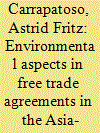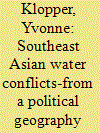|
|
|
Sort Order |
|
|
|
Items / Page
|
|
|
|
|
|
|
| Srl | Item |
| 1 |
ID:
082654


|
|
|
|
|
| Publication |
2008.
|
| Summary/Abstract |
While cities are considered to be inherently unsustainable, these urban human settlements will be where a majority of the population will be living in the next two to three decades. Among the ten largest cities in the world in terms of population sizes, three are in Southeast Asia alone and more than one in two people will be living in cities in 2025. These primate cities-Metro-Manila in the Philippines, Jakarta in Indonesia and Bangkok in Thailand-are seeing not only rapid rates of in-migration but also rapid expansion and urban sprawl. Such rapid rates of change pose growing challenges to Southeast Asian cities including smaller capital cities like Kuala Lumpur, Ho Chi Minh City and Singapore. The strongest challenge concern infrastructural provision and particularly that provided for urban transport and mobility. Urban traffic congestion is an issue that is common to most Southeast Asian cities including Singapore which has introduced relatively draconian policy measures to both contain the level of car ownership and the use of the car. A comparison with several European cities highlight where Southeast Asian cities can review their own urban transport policies. This paper focuses on the lessons that can be learnt from a comparative study of the infrastructural provision and public policies that are in place in Southeast Asian and European cities
|
|
|
|
|
|
|
|
|
|
|
|
|
|
|
|
| 2 |
ID:
082662


|
|
|
|
|
| Publication |
2008.
|
| Summary/Abstract |
The paper outlines the major efforts in developing the environmental management mechanism in Myanmar. It covers the inception of a national level organization established to handle the environmental issues of the country: why it is not so effective as intended, examines the current laws and policies designed to address these issues, discusses the current practices in environmental conservation and identifies new initiatives to integrate environmental policy objectives into sector-wise development policies
|
|
|
|
|
|
|
|
|
|
|
|
|
|
|
|
| 3 |
ID:
082658


|
|
|
|
|
| Publication |
2008.
|
| Summary/Abstract |
The trade and environment interface has become a topic of growing importance. Until the early 1990s, the General Agreement on Tariffs and Trade (GATT) and its successor, the Asia-Pacific Economic Cooperation(WTO), were the major forums to address the relationship between trade and the environment. Significant progress in this area has not yet been made. Since the 1990s, environmental issues have been addressed by the North American Free Trade Agreement (NAFTA) and in recent times by trans-regional and bilateral free trade agreements (FTAs) such as the Trans-Pacific Strategic Economic Partnership Agreement (SEP), the U.S.-Singapore FTA (USSFTA), the Canada-Chile FTA or the New Zealand-Thailand Closer Economic Partnership Agreement (CEP). Not only questions on the effectiveness of FTAs in global and regional environmental governance arise but also on the various actors involved in these negotiations. The question here is whether the integration of environmental issues in FTAs is a top-down approach, leaving the negotiations and implementation of environment cooperation frameworks in the hands of governments, or whether environmental arrangements are the result of a multi-stakeholder dialogue, consequently committing governments, the private sector and civil society to the objective of making trade and environmental policies mutually supportive. This article seeks to address these questions by analysing environmental issues and stakeholder participation in the Asia-Pacific Economic Cooperation (APEC), the Trans-Pacific SEP and the New Zealand-Thailand CEP.
|
|
|
|
|
|
|
|
|
|
|
|
|
|
|
|
| 4 |
ID:
082660


|
|
|
|
|
| Publication |
2008.
|
| Summary/Abstract |
The Asian region accounts for already over 40% of the global economy, and is becoming the world's main manufacturing hub. Unprecedented changes in economic growth and trade in the last couple of decades have resulted in severe degradation of the regional, as well as the global environment that could offset the advantages that economic growth has brought to the countries and their populations. In this framework the need to deploy sustainable energy technologies is a key concern for the global community. This paper gives an overview of EU programmes and policies to develop sustainable energy technologies and the common barriers faced to technology implementation in EU and Asian countries. Following that, the approaches and mechanisms that are used internationally for overcoming the barriers to technology transfer and implementation are presented. After having assessed barriers to technology implementation and possible ways and programmes to help overcome them, the paper provides specific examples of success stories of how government policies and programmes, in combination with involvement of the private sector, can be effective in sustainable energy technology transfer and implementation in both EU and Asian countries. Finally, the opportunity that has recently arisen to enhance the introduction of sustainable energy technologies in developing countries through the development of programmes of related activities as CDM projects is presented and indicative mutual benefits for the strengthening of the EU Asian partnership are highlighted
|
|
|
|
|
|
|
|
|
|
|
|
|
|
|
|
| 5 |
ID:
082655


|
|
|
|
|
| Publication |
2008.
|
| Summary/Abstract |
The paper argues that for EU-Japan cooperation the time has come to move from declarations of intent to action. It is suggested that in order to function and to last the cooperation needs a framework that pulls together and organizes different cooperation areas and concrete projects. The framework, it is suggested, should be a flexible "Structured Cooperation" in and under which cooperation would be treated as a negotiating project, in which the advantages and benefits of individual projects would lead to an agreed BoB-balance of benefits. To ensure delivery and allow for adjustments, adding and adjusting of subjects etc. a management and surveillance structure would be required to ensure an enduring interest of both sides in continuing cooperation. The individual cooperation projects, it is suggested, should be organized around common themes-the pillars-for better coherence and management. In a second part the paper suggests a practical and feasible cooperation project for improving the energy efficiency of some products widely used in Asia. That proposal uses the main elements of a relatively easy to implement approach that has been successfully applied in Europe. This approach has the advantage over others to make harmonization of efficiency requirements for energy using products in Asia possible, without the need to engage in time consuming and potentially controversial mutual recognition negotiations of national standards or the need to harmonize national Asian standards.
|
|
|
|
|
|
|
|
|
|
|
|
|
|
|
|
| 6 |
ID:
082659


|
|
|
|
|
| Publication |
2008.
|
| Summary/Abstract |
With the progress of European integration, the European environmental policy and law, from zero to bloom, approximately experienced a three- stage development, namely a forming period, an establishing period and a developing period. Environmental policy is no longer a byproduct of the construction of the common market, but has become a significant instrument for realizing the European sustainable development. On the occasion of the amendment of the European treaties, the legal foundation of environmental policy became clear, decision-making mechanism evolved, and implementation measures varied. However, European environmental actions are still constrained by the division of competences between the Union and member states. Moreover, with the trend of deregulation it remains also a tough task for EU on how to effectively realize the objective of sustainable development
|
|
|
|
|
|
|
|
|
|
|
|
|
|
|
|
| 7 |
ID:
082661


|
|
|
|
|
| Publication |
2008.
|
| Summary/Abstract |
In 2005 Indonesian and European institutes joined to start the first step for the implementation of an Ocean Operational System in the Indonesian archipelago. The system will support the decision making process for the sustainable use of marine resources, providing useful information and added value products as well as a service for an improved management of the sea with high business impact to targeted groups as public authorities and commercial operators (coastal managers, fishermen, shipping companies). In this paper the System is shortly described with its potential benefits and economic and social impacts
|
|
|
|
|
|
|
|
|
|
|
|
|
|
|
|
| 8 |
ID:
082656


|
|
|
|
|
| Publication |
2008.
|
| Summary/Abstract |
Due to economic interdependency through trade and investment, economies of scale, and economic complementarities, China and the European Union (EU) have a huge potential for cooperation. Already many things have happened so far. Since 2004, the cooperation on climate change has been a key issue on the political agenda of China-EU summits. In 2005, the EU and China even endorsed a "Joint Declaration on Climate Change" which emphasizes reducing the cost of clean energy key technologies for China, first and foremost through the development and deployment of near-to-zero-emission CCS technology. Letting China gain access to clean energy technology is the key issue of climate change cooperation. Despite great efforts and potential mutual benefits, this is still a field of conflicting interests. The authors argue that currently, cooperation on the transfer of clean energy technology is very limited due to rational interests of the actors and the insecurities involved in cooperation
|
|
|
|
|
|
|
|
|
|
|
|
|
|
|
|
| 9 |
ID:
082663


|
|
|
|
|
| Publication |
2008.
|
| Summary/Abstract |
This article analyzes water-related conflicts in Southeast Asia and draws the attention to controversial dam-and hydropower-schemes. It focuses on three dam projects in Thailand, Laos and Burma that are all interwoven by different characteristics of development assistance. But they also slightly differ in terms of the implementation stage, the geopolitical setting, the socio-economical frameworks and the actors involved. Against this analytical background, the approach unveils the complexity of internationalising conflicts that are created under the influence of the ongoing globalisation and by multiple actors involved, their networks, strategies and power relations. "Scarcity of resources-securing energy by development assistance" provides a brief introduction by drawing the main global configurations. "Energy supply and poverty alleviation-new dams in Southeast Asia" zooms in on the specific stage by mirroring dam disputes in Southeast Asia (SEA). Based on these fundamentals, in "Different dams-diverse actors and conflict potentials" the case studies are reconstructed to highlight the multiplicity of dam-projects and inherent controversies. "Conclusion-new conflict frameworks require new instruments of dispute resolution" offers an outlook on conceptual ideas on how to deal with future dam disputes under the auspices of development assistance
|
|
|
|
|
|
|
|
|
|
|
|
|
|
|
|
|
|
|
|
|